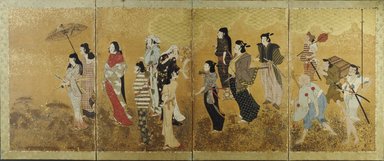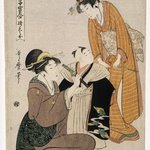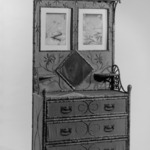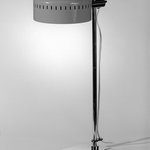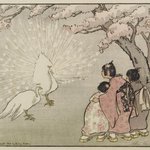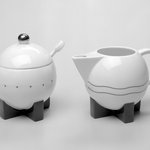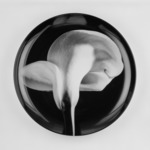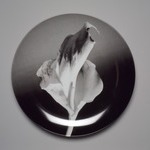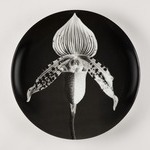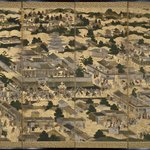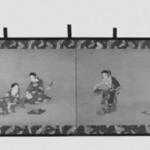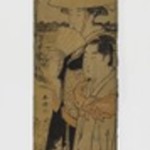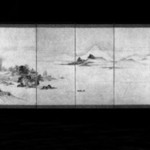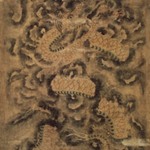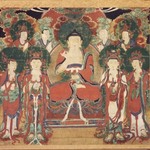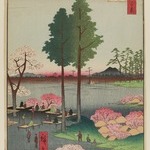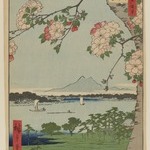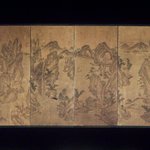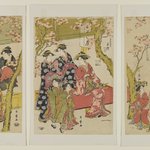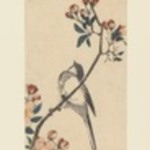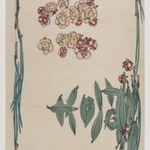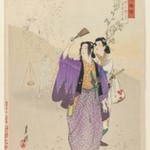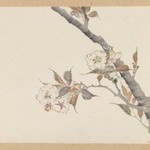Cherry Blossom Viewing Picnic
Asian Art
In Japan the seventeenth century witnessed an era of political stability that was characterized by an increased prominence of urban culture and a dramatic rise in the economic and social status of formerly middle-class groups such as merchants, artisans, and the lesser ranks of the military. These groups used their new prosperity to support new genres of art that represented urban life, particularly the fashionable activities of the entertainment districts.
The Cherry Blossom Viewing screen can be considered a very early prototype for ukiyo-e painting (literally, "pictures of the floating world"). Better known from woodblock prints, ukiyo-e portrays popular actors, beautiful women, famous sites, and such popular diversions as the springtime tradition of cherry blossom viewing. The highly fashionable crowd making its way across the screen is actually professional pleasure women (yujo) and their clients, who are low-ranking samurai. While the scene carries various levels of meaning, romance is implied by the action of a woman extending a branch of cherry blossoms with a poem strip (tanzaku) to the men following behind.
MEDIUM
Ink, color and gold leaf on paper
DATES
ca. 1624–1644
PERIOD
Edo Period, Kan'ei Era
DIMENSIONS
Overall: 39 3/8 x 105 7/8in. (100 x 268.9cm)
Other: 33 9/16 x 86 1/2in. (85.2 x 219.7cm)
Image (outer panel): 33 7/8 x 20 1/2 in. (86 x 52.1 cm)
Image (inner panel): 33 7/8 x 22 5/8 in. (86 x 57.5 cm)
(show scale)
ACCESSION NUMBER
39.87
CREDIT LINE
Gift of Frederic B. Pratt
CATALOGUE DESCRIPTION
Four-fold screen. A procession of large figures with very little background. The paper is a golden brown with gold and silver flecks. Gold representing clouds is used at the top of the painting. There are fifteen figures in all, the first carrying a fan and wearing swords, accompanied by another who bears an umbrella. A person with a pipe, one holding a branch of flowers and others with swords and fans follow. In the rear are four servants, one carrying a musical instrument, another a trunk and the others swords etc. Many colors are used in the costumes which show detailed designs. Red, blue, white, gray, brown, black, gold, green appear in various tones, the whole presenting a varied and vivid effect. There are narrow borders of white silk with a design in silver threads. The wide borders are of blue silk brocade with gold threads in an all over geometric design with conventionalized floral and foliate patterns.
There are two well-known paintings which relate to the Brooklyn screen. The most famous and often reproduced example is the kakemono, formerly from a screen or sliding door, now in the Atami Museum and published by Adachi, "Yuna zu kai," Kokka; No. 525, p218 (and also in Kondo, Japanese Genre Painting, pl. 8, Narazaki and Kikuchi, Shoki Ukiyo-e pl. 56, and elsewhere). The Atami painting is very much like our screen, differing only in details, and the groups of yuna are also looking backward. The second painting which relates to ours is the four panel screen called the Pleasures of Women published in Kondo, op. cit., pls. 4 and 89. The subject here is quite different, centered about a picnic scene with sixteen yuna and one young male, but the handling of figures as well as the treatment of the cloud forms is identical with our screen, suggesting that it is the mate to the Brooklyn piece. In addition, note should be made of the pair of screens devoted to bath-girls in the Freer Gallery collection (see Stern, Ukiyo-e Painting: Selected Problems (1960), pls. 14 and 15). These are in a very similar style.
MUSEUM LOCATION
This item is not on view
CAPTION
Cherry Blossom Viewing Picnic, ca. 1624–1644. Ink, color and gold leaf on paper, Overall: 39 3/8 x 105 7/8in. (100 x 268.9cm). Brooklyn Museum, Gift of Frederic B. Pratt, 39.87. Creative Commons-BY (Photo: Brooklyn Museum, 39.87_SL3.jpg)
IMAGE
overall, 39.87_SL3.jpg. Brooklyn Museum photograph
"CUR" at the beginning of an image file name means that the image was created by a curatorial staff member. These study images may be digital point-and-shoot photographs, when we don\'t yet have high-quality studio photography, or they may be scans of older negatives, slides, or photographic prints, providing historical documentation of the object.
RIGHTS STATEMENT
Creative Commons-BY
You may download and use Brooklyn Museum images of this three-dimensional work in accordance with a
Creative Commons license. Fair use, as understood under the United States Copyright Act, may also apply.
Please include caption information from this page and credit the Brooklyn Museum. If you need a high resolution file, please fill out our online
application form (charges apply).
For further information about copyright, we recommend resources at the
United States Library of Congress,
Cornell University,
Copyright and Cultural Institutions: Guidelines for U.S. Libraries, Archives, and Museums, and
Copyright Watch.
For more information about the Museum's rights project, including how rights types are assigned, please see our
blog posts on copyright.
If you have any information regarding this work and rights to it, please contact
copyright@brooklynmuseum.org.
RECORD COMPLETENESS
Not every record you will find here is complete. More information is available for some works than for others, and some entries have been updated more recently. Records are frequently reviewed and revised, and
we welcome any additional information you might have.
